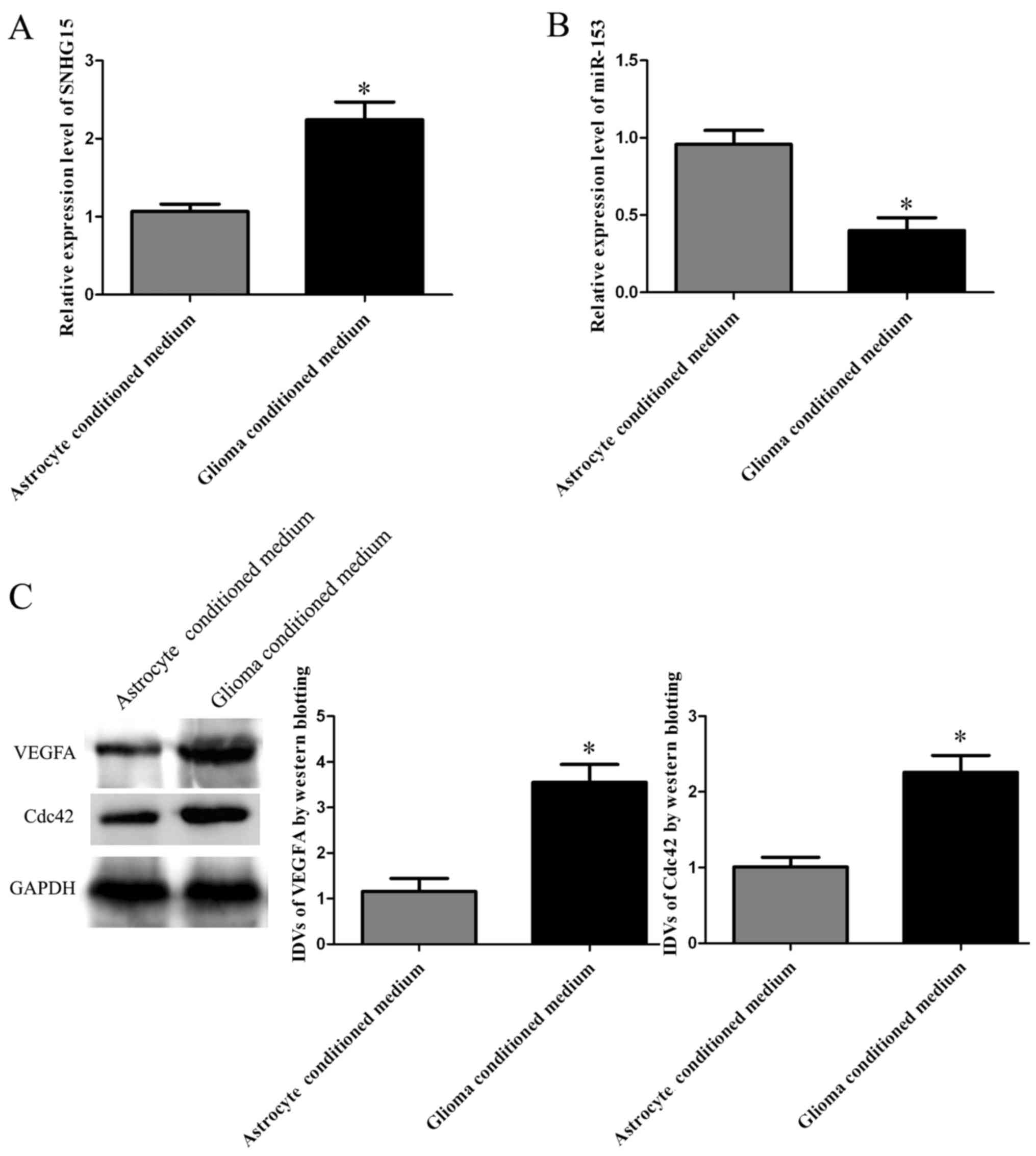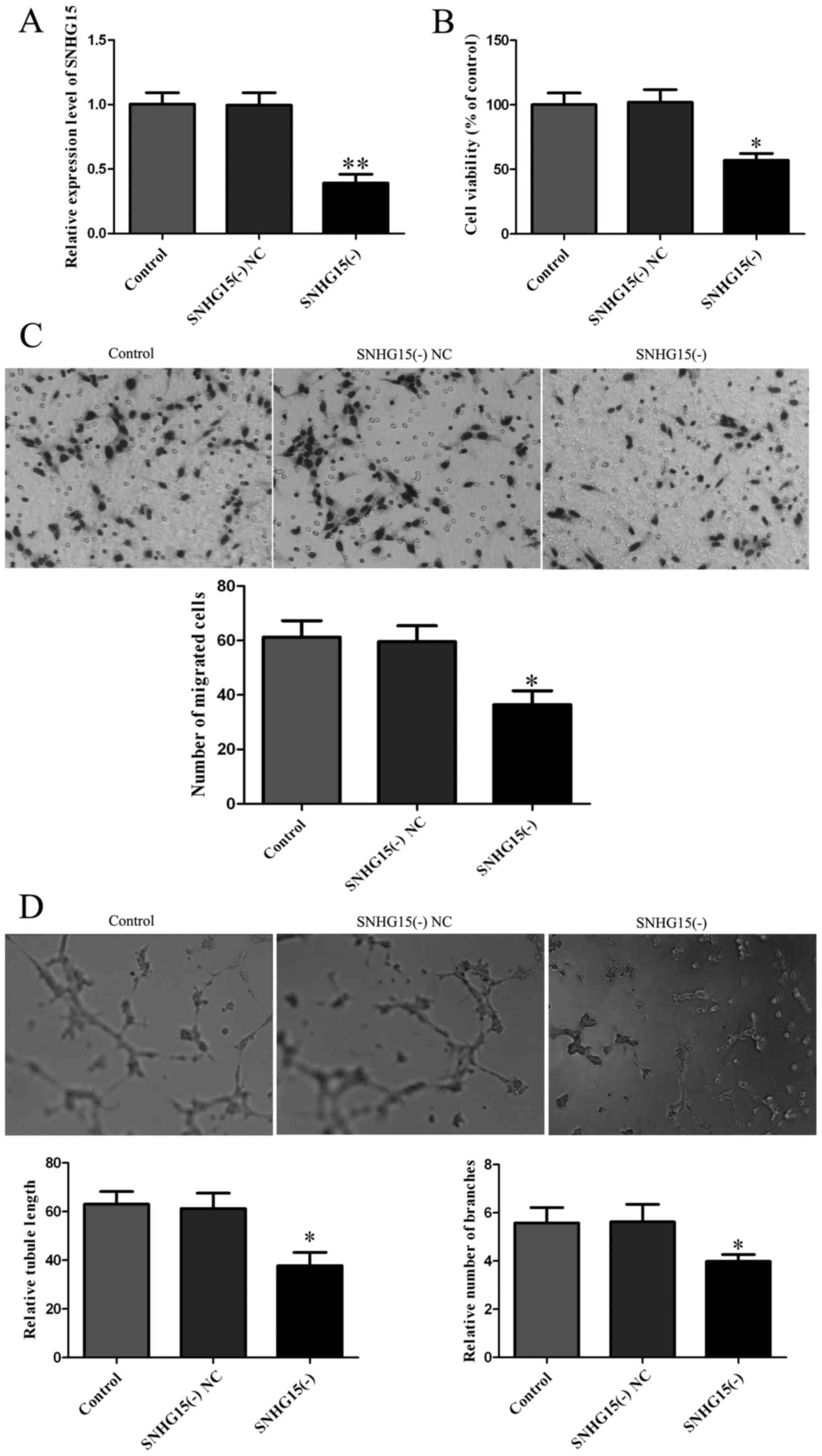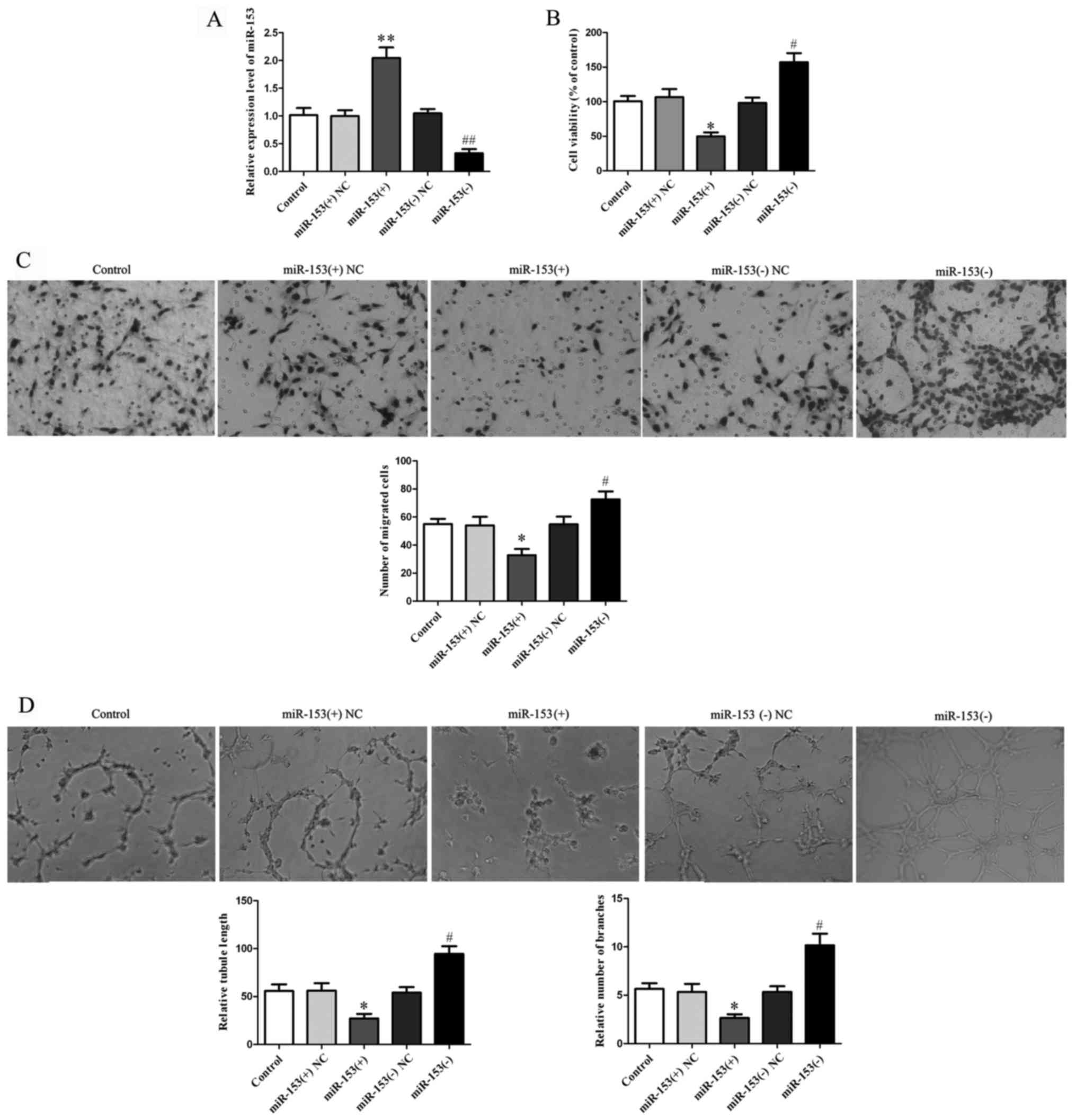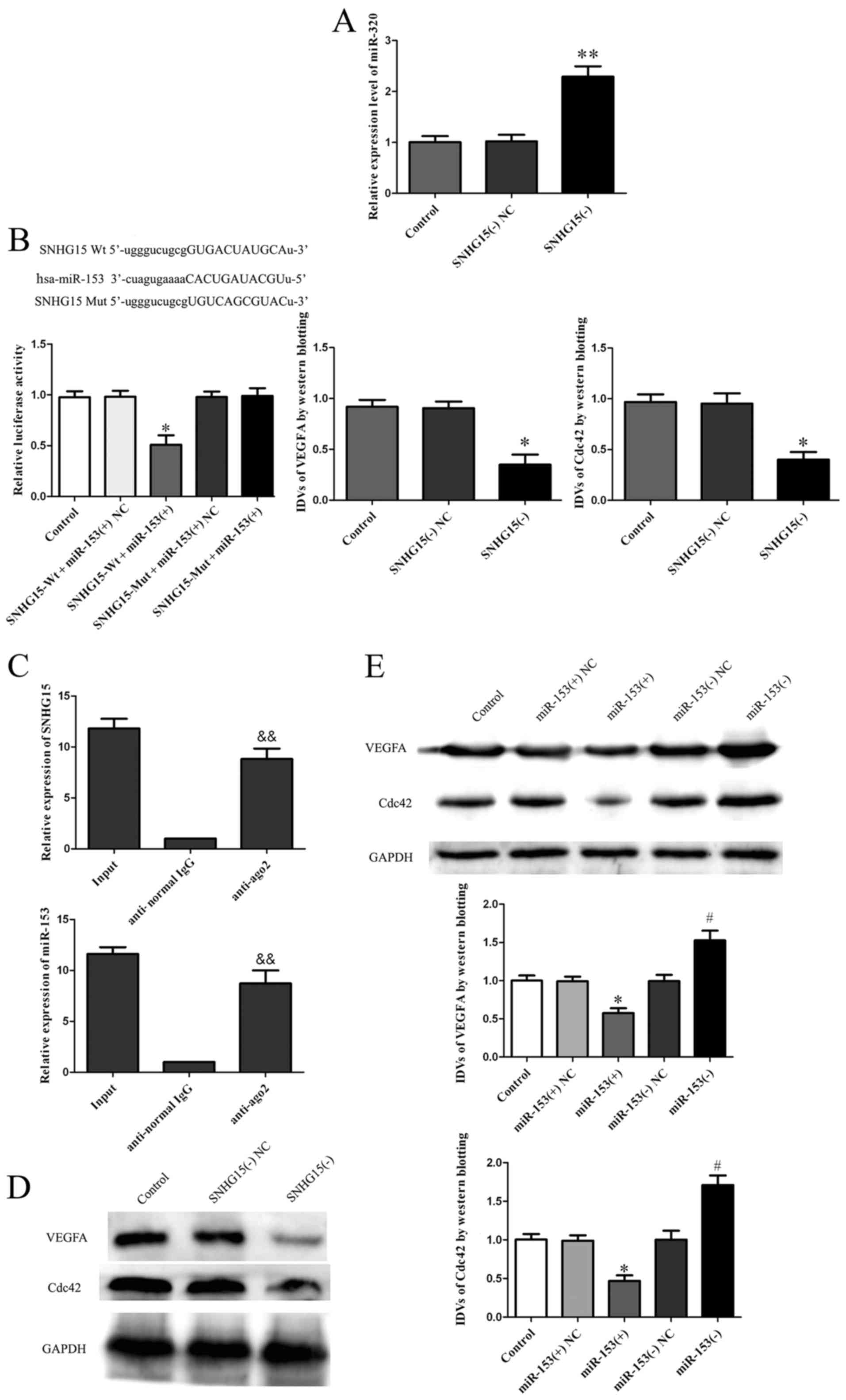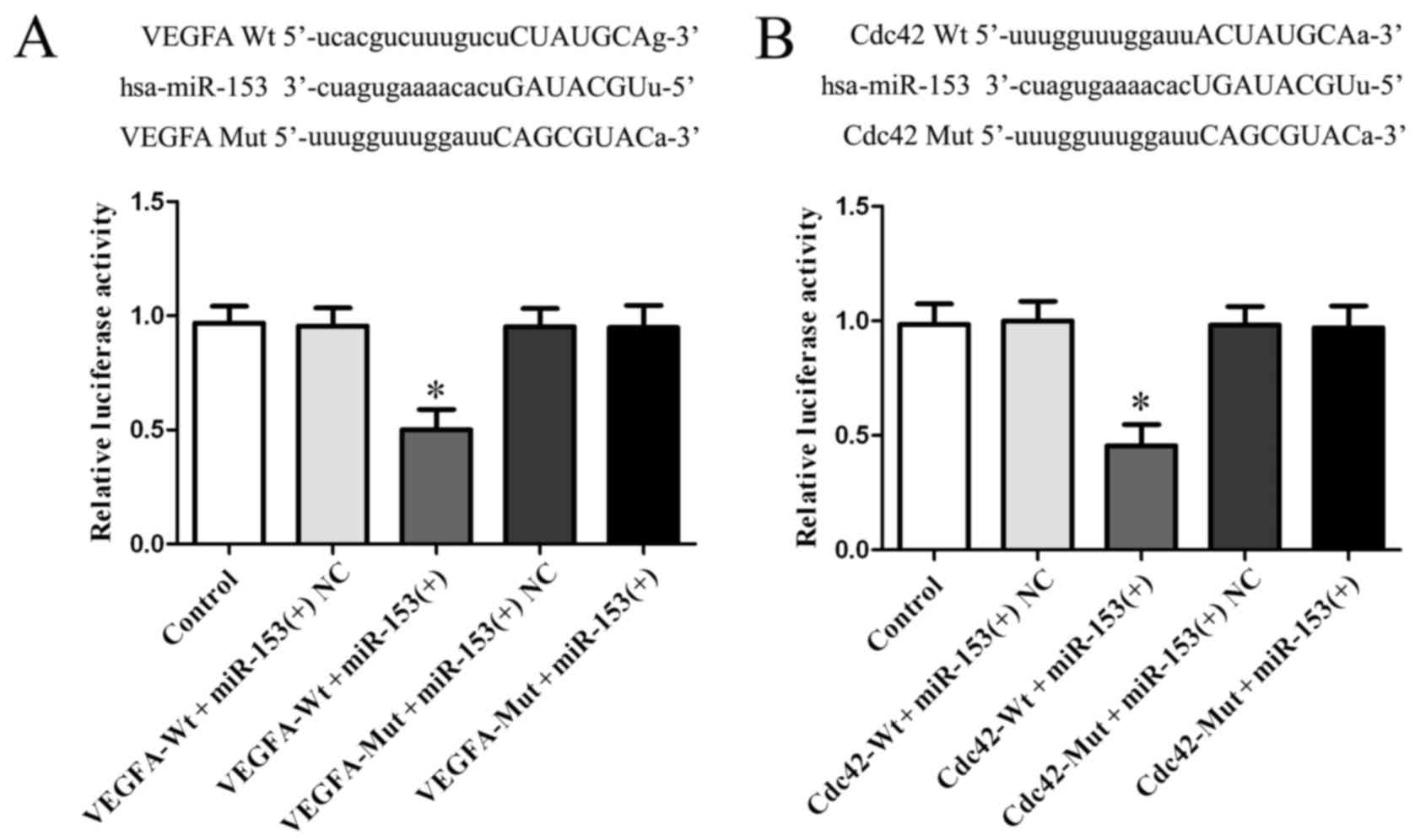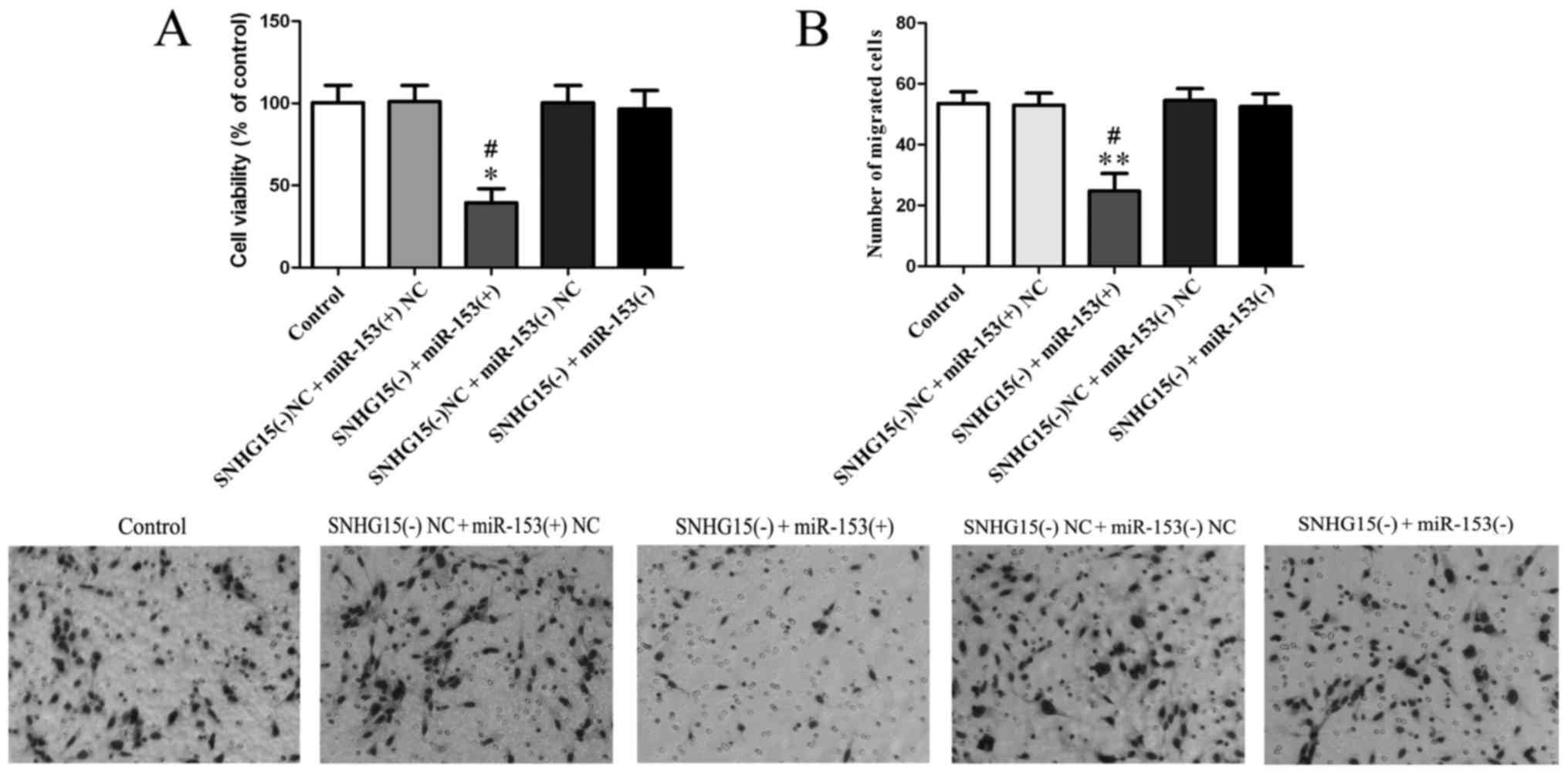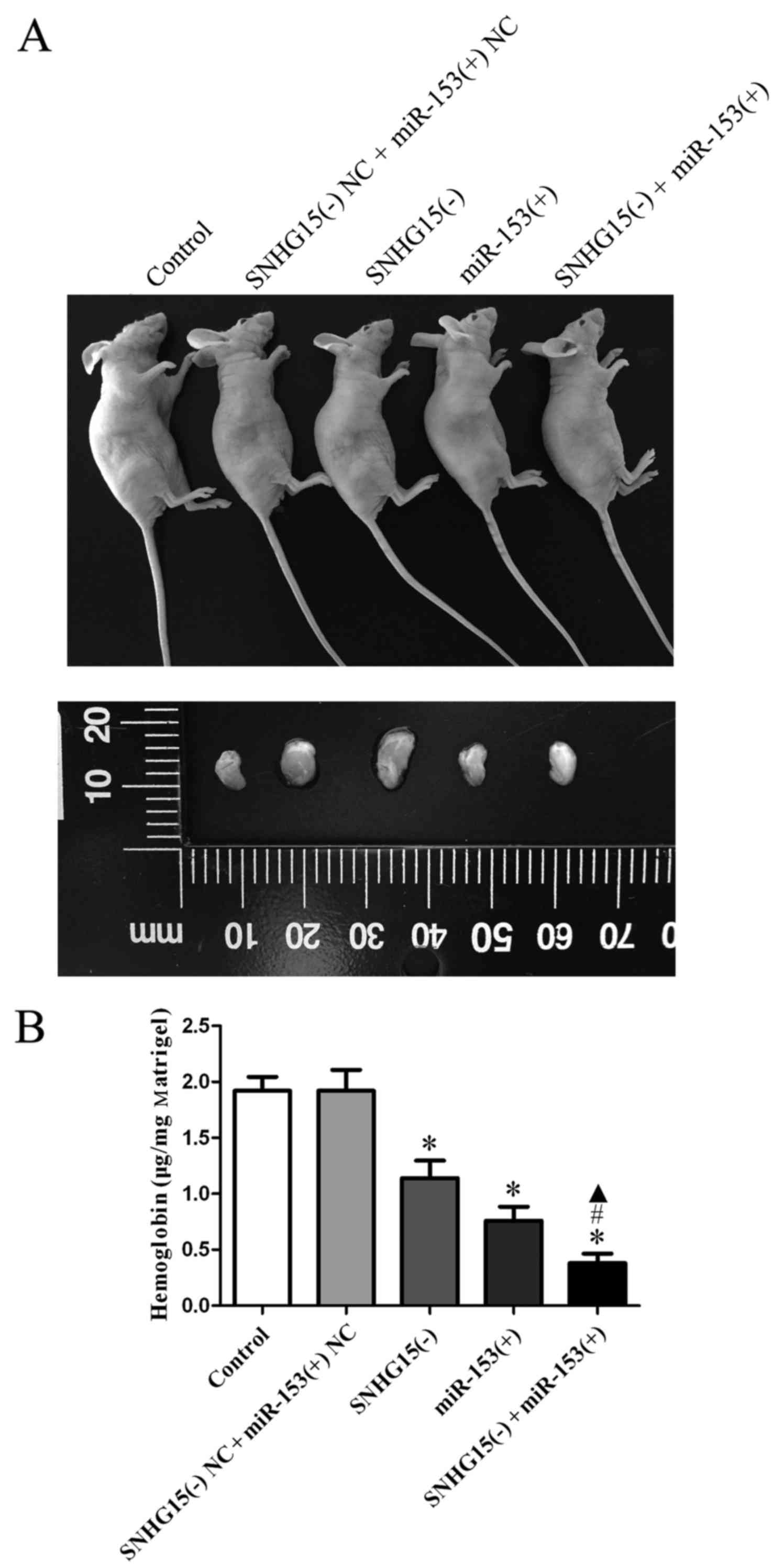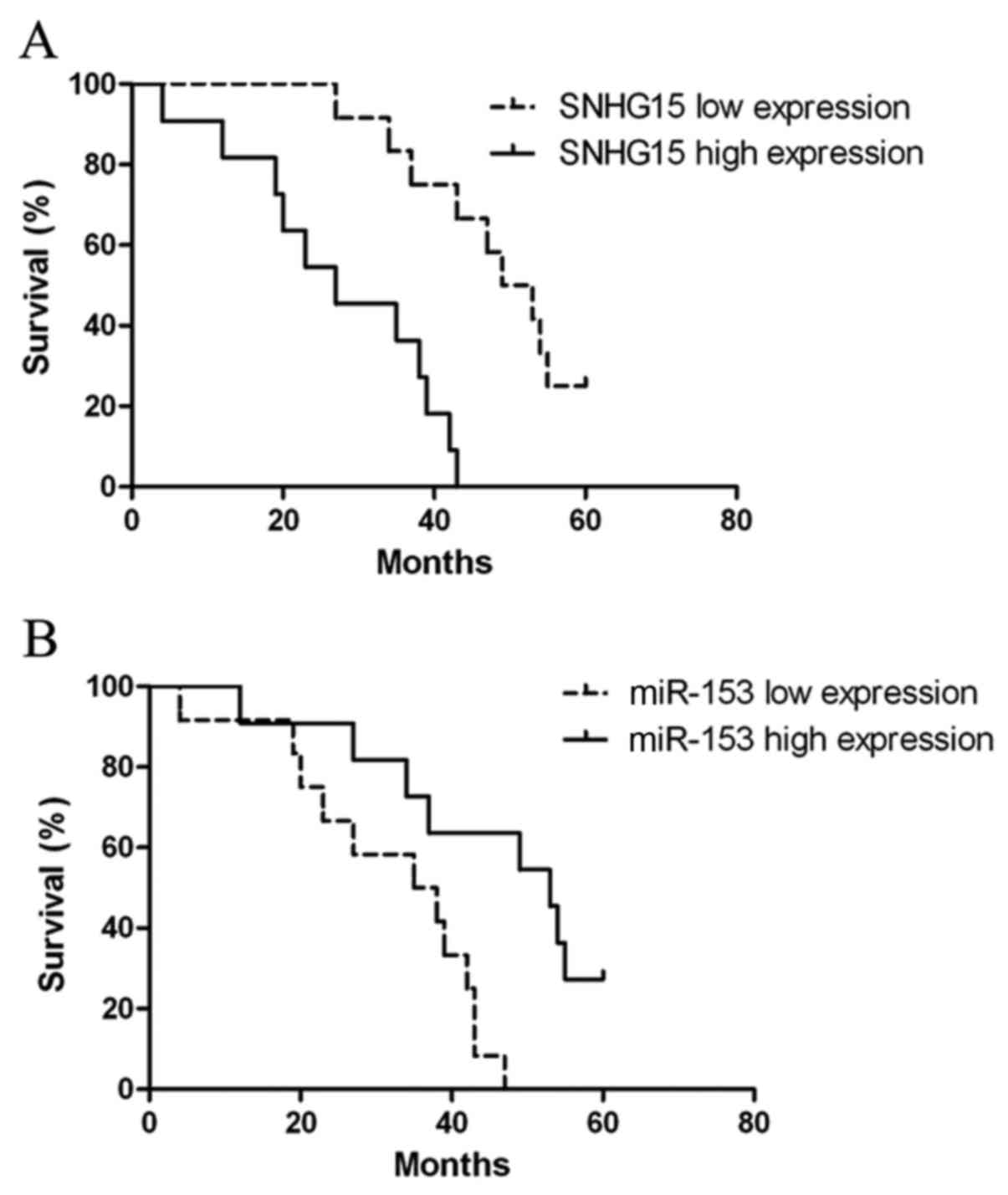|
1
|
Weller M, Van den Bent M, Hopkins K, Tonn
JC, Stupp R, Falini A, Cohen-Jonathan-Moyal E, Frappaz D,
Henriksson R, Balana C, et al European Association for
Neuro-Oncology (EANO) Task Force on Malignant Glioma, : EANO
guideline for the diagnosis and treatment of anaplastic gliomas and
glioblastoma. Lancet Oncol. 15:e395–e403. 2014. View Article : Google Scholar : PubMed/NCBI
|
|
2
|
Dimberg A: The glioblastoma vasculature as
a target for cancer therapy. Biochem Soc Trans. 42:1647–1652. 2014.
View Article : Google Scholar : PubMed/NCBI
|
|
3
|
Polivka J Jr, Polivka J, Rohan V, Topolcan
O and Ferda J: New molecularly targeted therapies for glioblastoma
multiforme. Anticancer Res. 32:2935–2946. 2012.PubMed/NCBI
|
|
4
|
Patel M, Vogelbaum MA, Barnett GH, Jalali
R and Ahluwalia MS: Molecular targeted therapy in recurrent
glioblastoma: Current challenges and future directions. Expert Opin
Investig Drugs. 21:1247–1266. 2012. View Article : Google Scholar : PubMed/NCBI
|
|
5
|
Yang W, Barth RF, Huo T, Nakkula RJ,
Weldon M, Gupta N, Agius L and Grecula JC: Radiation therapy
combined with intracerebral administration of carboplatin for the
treatment of brain tumors. Radiat Oncol. 9:252014. View Article : Google Scholar : PubMed/NCBI
|
|
6
|
Brem S, Cotran R and Folkman J: Tumor
angiogenesis: A quantitative method for histologic grading. J Natl
Cancer Inst. 48:347–356. 1972.PubMed/NCBI
|
|
7
|
Lopes-Bastos BM, Jiang WG and Cai J:
Tumour-endothelial cell communications: Important and indispensable
mediators of tumour angiogenesis. Anticancer Res. 36:1119–1126.
2016.PubMed/NCBI
|
|
8
|
Zecchin A, Borgers G and Carmeliet P:
Endothelial cells and cancer cells: Metabolic partners in crime?
Curr Opin Hematol. 22:234–242. 2015. View Article : Google Scholar : PubMed/NCBI
|
|
9
|
Dunn IF, Heese O and Black PM: Growth
factors in glioma angiogenesis: FGFs, PDGF, EGF, and TGFs. J
Neurooncol. 50:121–137. 2000. View Article : Google Scholar : PubMed/NCBI
|
|
10
|
Egidy G, Eberl LP, Valdenaire O, Irmler M,
Majdi R, Diserens AC, Fontana A, Janzer RC, Pinet F and
Juillerat-Jeanneret L: The endothelin system in human glioblastoma.
Lab Invest. 80:1681–1689. 2000. View Article : Google Scholar : PubMed/NCBI
|
|
11
|
Cai H, Xue Y, Li Z, Hu Y, Wang Z, Liu W,
Li Z and Liu Y: Roundabout4 suppresses glioma-induced endothelial
cell proliferation, migration and tube formation in vitro by
inhibiting VEGR2-mediated PI3K/AKT and FAK signaling pathways. Cell
Physiol Biochem. 35:1689–1705. 2015. View Article : Google Scholar : PubMed/NCBI
|
|
12
|
Smits M, Wurdinger T, van het Hof B,
Drexhage JA, Geerts D, Wesseling P, Noske DP, Vandertop WP, de
Vries HE and Reijerkerk A: Myc-associated zinc finger protein (MAZ)
is regulated by miR-125b and mediates VEGF-induced angiogenesis in
glioblastoma. FASEB J. 26:2639–2647. 2012. View Article : Google Scholar : PubMed/NCBI
|
|
13
|
Angrand PO, Vennin C, Le Bourhis X and
Adriaenssens E: The role of long non-coding RNAs in genome
formatting and expression. Front Genet. 6:1652015. View Article : Google Scholar : PubMed/NCBI
|
|
14
|
Svoboda M, Slyskova J, Schneiderova M,
Makovicky P, Bielik L, Levy M, Lipska L, Hemmelova B, Kala Z,
Protivankova M, et al: HOTAIR long non-coding RNA is a negative
prognostic factor not only in primary tumors, but also in the blood
of colorectal cancer patients. Carcinogenesis. 35:1510–1515. 2014.
View Article : Google Scholar : PubMed/NCBI
|
|
15
|
Ding C, Cheng S, Yang Z, Lv Z, Xiao H, Du
C, Peng C, Xie H, Zhou L, Wu J, et al: Long non-coding RNA HOTAIR
promotes cell migration and invasion via down-regulation of RNA
binding motif protein 38 in hepatocellular carcinoma cells. Int J
Mol Sci. 15:4060–4076. 2014. View Article : Google Scholar : PubMed/NCBI
|
|
16
|
Kim K, Jutooru I, Chadalapaka G, Johnson
G, Frank J, Burghardt R, Kim S and Safe S: HOTAIR is a negative
prognostic factor and exhibits pro-oncogenic activity in pancreatic
cancer. Oncogene. 32:1616–1625. 2013. View Article : Google Scholar : PubMed/NCBI
|
|
17
|
Okugawa Y, Toiyama Y, Hur K, Toden S,
Saigusa S, Tanaka K, Inoue Y, Mohri Y, Kusunoki M, Boland CR, et
al: Metastasis-associated long non-coding RNA drives gastric cancer
development and promotes peritoneal metastasis. Carcinogenesis.
35:2731–2739. 2014. View Article : Google Scholar : PubMed/NCBI
|
|
18
|
Ke J, Yao YL, Zheng J, Wang P, Liu YH, Ma
J, Li Z, Liu XB, Li ZQ, Wang ZH, et al: Knockdown of long
non-coding RNA HOTAIR inhibits malignant biological behaviors of
human glioma cells via modulation of miR-326. Oncotarget.
6:21934–21949. 2015. View Article : Google Scholar : PubMed/NCBI
|
|
19
|
Chen SX, Yin JF, Lin BC, Su HF, Zheng Z,
Xie CY and Fei ZH: Upregulated expression of long noncoding RNA
SNHG15 promotes cell proliferation and invasion through regulates
MMP2/MMP9 in patients with GC. Tumour Biol. 37:6801–6812. 2016.
View Article : Google Scholar : PubMed/NCBI
|
|
20
|
Zhang JH, Wei HW and Yang HG: Long
noncoding RNA SNHG15, a potential prognostic biomarker for
hepatocellular carcinoma. Eur Rev Med Pharmacol Sci. 20:1720–1724.
2016.PubMed/NCBI
|
|
21
|
Zheng Y, Zhu C, Ma L, Shao P, Qin C, Li P,
Cao Q, Ju X, Cheng G, Zhu Q, et al: miRNA-154-5p inhibits
proliferation, migration and invasion by targeting E2F5 in prostate
cancer cell lines. Urol Int. 98:102–110. 2017. View Article : Google Scholar : PubMed/NCBI
|
|
22
|
Xue Z, Yilan D, Ping J and Fei M:
Bioinformatic analysis of cancer-related microRNAs and their target
genes. Yi Chuan. 37:855–864. 2015.PubMed/NCBI
|
|
23
|
Roy S and Sen CK: miRNA in wound
inflammation and angiogenesis. Microcirculation. 19:224–232. 2012.
View Article : Google Scholar : PubMed/NCBI
|
|
24
|
Wu X, Li L, Li Y and Liu Z: MiR-153
promotes breast cancer cell apoptosis by targeting HECTD3. Am J
Cancer Res. 6:1563–1571. 2016.PubMed/NCBI
|
|
25
|
Sun Y, Jia X, Hou L and Liu X: Screening
of differently expressed miRNA and mRNA in prostate cancer by
integrated analysis of transcription data. Urology.
94:313.e1–313.e6. 2016. View Article : Google Scholar
|
|
26
|
Chen WJ, Zhang EN, Zhong ZK, Jiang MZ,
Yang XF, Zhou DM and Wang XW: MicroRNA-153 expression and prognosis
in non-small cell lung cancer. Int J Clin Exp Pathol. 8:8671–8675.
2015.PubMed/NCBI
|
|
27
|
Ghasemi A, Fallah S and Ansari M: miR-153
as a tumor suppressor in glioblastoma multiforme is downregulated
by DNA methylation. Clin Lab. 62:573–580. 2016. View Article : Google Scholar : PubMed/NCBI
|
|
28
|
Yang L, Hu S, Tan J, Zhang X, Yuan W, Wang
Q, Xu L, Liu J, Liu Z, Jia Y, et al: Pregnancy-specific
glycoprotein 9 (PSG9), a driver for colorectal cancer, enhances
angiogenesis via activation of SMAD4. Oncotarget. 7:61562–61574.
2016. View Article : Google Scholar : PubMed/NCBI
|
|
29
|
Wu J, Yuan P, Mao Q, Lu P, Xie T, Yang H
and Wang C: miR-613 inhibits proliferation and invasion of breast
cancer cell via VEGFA. Biochem Biophys Res Commun. 478:274–278.
2016. View Article : Google Scholar : PubMed/NCBI
|
|
30
|
Cai H, Liu X, Zheng J, Xue Y, Ma J, Li Z,
Xi Z, Li Z, Bao M and Liu Y: Long non-coding RNA taurine
upregulated 1 enhances tumor-induced angiogenesis through
inhibiting microRNA-299 in human glioblastoma. Oncogene.
36:318–331. 2017. View Article : Google Scholar : PubMed/NCBI
|
|
31
|
Garzon-Muvdi T, Schiapparelli P, ap Rhys
C, Guerrero-Cazares H, Smith C, Kim DH, Kone L, Farber H, Lee DY,
An SS, et al: Regulation of brain tumor dispersal by NKCC1 through
a novel role in focal adhesion regulation. PLoS Biol.
10:e10013202012. View Article : Google Scholar : PubMed/NCBI
|
|
32
|
Senger DL, Tudan C, Guiot MC, Mazzoni IE,
Molenkamp G, LeBlanc R, Antel J, Olivier A, Snipes GJ and Kaplan
DR: Suppression of Rac activity induces apoptosis of human glioma
cells but not normal human astrocytes. Cancer Res. 62:2131–2140.
2002.PubMed/NCBI
|
|
33
|
Jia P, Cai H, Liu X, Chen J, Ma J, Wang P,
Liu Y, Zheng J and Xue Y: Long non-coding RNA H19 regulates glioma
angiogenesis and the biological behavior of glioma-associated
endothelial cells by inhibiting microRNA-29a. Cancer Lett.
381:359–369. 2016. View Article : Google Scholar : PubMed/NCBI
|
|
34
|
Leon SP, Folkerth RD and Black PM:
Microvessel density is a prognostic indicator for patients with
astroglial brain tumors. Cancer. 77:362–372. 1996. View Article : Google Scholar : PubMed/NCBI
|
|
35
|
Plate KH and Risau W: Angiogenesis in
malignant gliomas. Glia. 15:339–347. 1995. View Article : Google Scholar : PubMed/NCBI
|
|
36
|
Pen A, Moreno MJ, Martin J and
Stanimirovic DB: Molecular markers of extracellular matrix
remodeling in glioblastoma vessels: Microarray study of
laser-captured glioblastoma vessels. Glia. 55:559–572. 2007.
View Article : Google Scholar : PubMed/NCBI
|
|
37
|
Mustafa DA, Dekker LJ, Stingl C, Kremer A,
Stoop M, Smitt PA Sillevis, Kros JM, Luider TM, et al: A proteome
comparison between physiological angiogenesis and angiogenesis in
glioblastoma. Mol Cell Proteomics. 11:M111.0084662012. View Article : Google Scholar : PubMed/NCBI
|
|
38
|
Tani H and Torimura M: Identification of
short-lived long non-coding RNAs as surrogate indicators for
chemical stress response. Biochem Biophys Res Commun. 439:547–551.
2013. View Article : Google Scholar : PubMed/NCBI
|
|
39
|
Josipovic I, Fork C, Preussner J, Prior
KK, Iloska D, Vasconez AE, Labocha S, Angioni C, Thomas D,
Ferreirós N, et al: PAFAH1B1 and the lncRNA NONHSAT073641 maintain
an angiogenic phenotype in human endothelial cells. Acta Physiol.
218:13–27. 2016.
|
|
40
|
Michalik KM, You X, Manavski Y,
Doddaballapur A, Zörnig M, Braun T, John D, Ponomareva Y, Chen W,
Uchida S, et al: Long noncoding RNA MALAT1 regulates endothelial
cell function and vessel growth. Circ Res. 114:1389–1397. 2014.
View Article : Google Scholar : PubMed/NCBI
|
|
41
|
Yan B, Yao J, Liu JY, Li XM, Wang XQ, Li
YJ, Tao ZF, Song YC, Chen Q and Jiang Q: lncRNA-MIAT regulates
microvascular dysfunction by functioning as a competing endogenous
RNA. Circ Res. 116:1143–1156. 2015. View Article : Google Scholar : PubMed/NCBI
|
|
42
|
Sempere LF, Freemantle S, Pitha-Rowe I,
Moss E, Dmitrovsky E and Ambros V: Expression profiling of
mammalian microRNAs uncovers a subset of brain-expressed microRNAs
with possible roles in murine and human neuronal differentiation.
Genome Biol. 5:R132004. View Article : Google Scholar : PubMed/NCBI
|
|
43
|
He T, Qi F, Jia L, Wang S, Wang C, Song N,
Fu Y, Li L and Luo Y: Tumor cell-secreted angiogenin induces
angiogenic activity of endothelial cells by suppressing miR-542-3p.
Cancer Lett. 368:115–125. 2015. View Article : Google Scholar : PubMed/NCBI
|
|
44
|
Miao YS, Zhao YY, Zhao LN, Wang P, Liu YH,
Ma J and Xue YX: MiR-18a increased the permeability of BTB via
RUNX1 mediated down-regulation of ZO-1, occludin and claudin-5.
Cell Signal. 27:156–167. 2015. View Article : Google Scholar : PubMed/NCBI
|
|
45
|
Carmeliet P: Mechanisms of angiogenesis
and arteriogenesis. Nat Med. 6:389–395. 2000. View Article : Google Scholar : PubMed/NCBI
|
|
46
|
Ferrara N: VEGF: An update on biological
and therapeutic aspects. Curr Opin Biotechnol. 11:617–624. 2000.
View Article : Google Scholar : PubMed/NCBI
|
|
47
|
Jin G, Yang Y, Liu H, Liu K, Zhao J, Chen
X, Zhang X, Zhang Y, Lu J and Dong Z: Genome-wide analysis of the
effect of esophageal squamous cell carcinoma on human umbilical
vein endothelial cells. Oncol Rep. 36:155–164. 2016. View Article : Google Scholar : PubMed/NCBI
|
|
48
|
Hoang MV, Nagy JA and Senger DR:
Cdc42-mediated inhibition of GSK-3β improves angio-architecture and
lumen formation during VEGF-driven pathological angiogenesis.
Microvasc Res. 81:34–43. 2011. View Article : Google Scholar : PubMed/NCBI
|
|
49
|
Tzima E, Kiosses WB, del Pozo MA and
Schwartz MA: Localized cdc42 activation, detected using a novel
assay, mediates microtubule organizing center positioning in
endothelial cells in response to fluid shear stress. J Biol Chem.
278:31020–31023. 2003. View Article : Google Scholar : PubMed/NCBI
|
|
50
|
Kouklis P, Konstantoulaki M, Vogel S,
Broman M and Malik AB: Cdc42 regulates the restoration of
endothelial barrier function. Circ Res. 94:159–166. 2004.
View Article : Google Scholar : PubMed/NCBI
|
|
51
|
Koh W, Mahan RD and Davis GE: Cdc42- and
Rac1-mediated endothelial lumen formation requires Pak2, Pak4 and
Par3, and PKC-dependent signaling. J Cell Sci. 121:989–1001. 2008.
View Article : Google Scholar : PubMed/NCBI
|
|
52
|
Cesana M, Cacchiarelli D, Legnini I,
Santini T, Sthandier O, Chinappi M, Tramontano A and Bozzoni I: A
long noncoding RNA controls muscle differentiation by functioning
as a competing endogenous RNA. Cell. 147:358–369. 2011. View Article : Google Scholar : PubMed/NCBI
|















